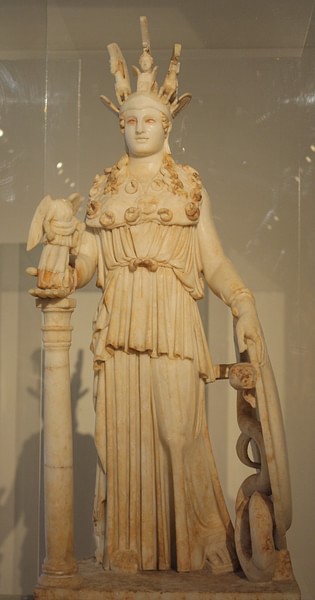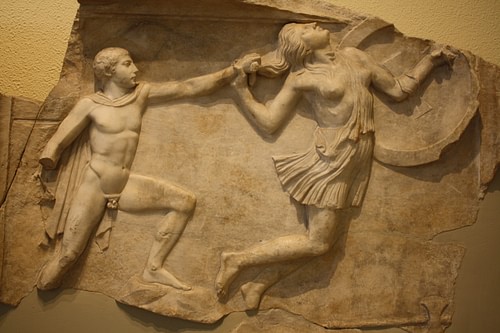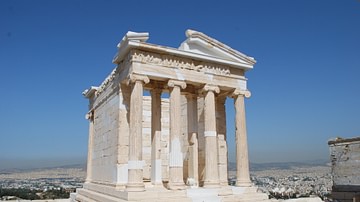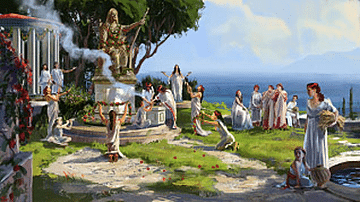The magnificent temple on the Acropolis of Athens, known as the Parthenon, was built between 447 and 432 BCE in the Golden Age of Pericles, and it was dedicated to the city's patron deity Athena. The temple was constructed to house the new gold and ivory cult statue of the goddess by the master sculptor Phidias (also Pheidias) and to proclaim to the world the success of Athens as leader of the coalition of Greek forces in the Persian Wars. The cult statue, begun in 447 BCE and dedicated in 438 BCE, would remain the great city's symbol for a thousand years until, in Late Antiquity, it disappeared from the historical record, possibly taken to Constantinople and there later destroyed. Fortunately, copies and representations, the most complete being the 2nd century CE 'Varvakeion statuette', of the statue and some of its sculptural details, along with descriptions by Plutarch and Pausanias, allow us to fairly accurately reconstruct its original appearance.

Materials & Dimensions
The name Parthenon derives from one of Athena's many epithets: Athena Parthenos, meaning Virgin. Parthenon means 'house of Parthenos' which was the name given in the 5th century BCE to the chamber (cella) inside the temple which housed the cult statue, and from the 4th century BCE the whole building acquired the name Parthenon.
Although richly decorated on the outside with magnificent decorative sculpture, the most important sculpture was always intended to be the giant statue of Athena inside it. Indeed, there is evidence that the temple was built to measure in order to accommodate the chryselephantine (gold and ivory) statue of Athena by Pheidias. The sculptor was already famous for his colossal bronze statue of Athena Promachos which stood on the acropolis and was reportedly visible from Cape Sounion, and he was commissioned by Pericles to create a statue worthy of the greatest city in Greece and its patron deity.
The Athena Parthenos was, then, a gigantic statue which, according to Pliny, was around 11.5 metres tall (26 cubits) and was made of carved ivory for flesh parts and gold (1140 kilos or 44 talents of it) for everything else, all wrapped around a wooden core. The gold parts could also be easily removed if necessary in times of financial necessity. Extra embellishments were rendered using glass, copper, silver, and jewels. It is estimated the statue cost the city around 5,000 talents, a truly huge sum of money which made it more expensive than the construction costs of the Parthenon itself.
The statue stood on a pedestal measuring 4.09 by 8.04 metres, faced the east door, and was surrounded by the Doric columns of a peristyle set inside the cella. In front of the statue, sunk into the flooring, was a large but shallow tank of water. This had the dual benefit of reflecting light into the chamber and maintaining a moist atmosphere to best preserve the ivory. The cutting in the temple floor in which the central support column of the statue was placed is still visible today.
Sculptural Decoration
The statue represented Athena standing majestic, fully armed and holding a 4 cubit tall statue of Nike in her right hand. Athena wore a peplos which was tucked into a belt. She held a large circular shield in her left hand which rests on the floor. She also has a spear on her left side, and a large coiled sacred snake resided between her feet and the shield. On her triple-crested helmet stood a sphinx and two griffins with Pegasus wings either side; griffins also decorated the cheek-pieces. On the goddess' chest was the snake-tasselled aegis given to her by Zeus with the head of the gorgon Medusa in ivory. The sides of Athena's sandals were decorated with the mythical battle between the centaurs and Lapiths. The base of the statue depicted scenes of the birth of Pandora, watched over by the most important gods of Mt. Olympus.
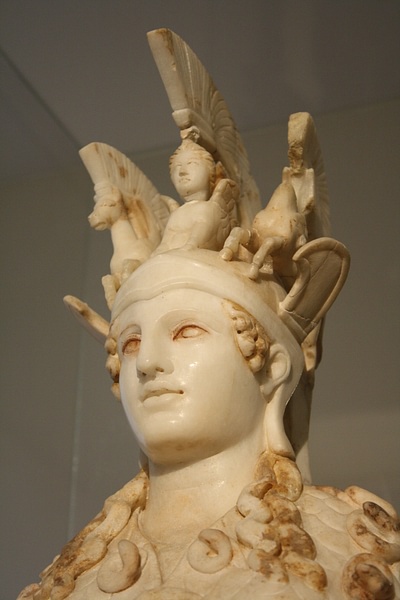
The shield of the statue was a wonder in itself and much copied in later antiquity. According to Pliny, it depicted scenes from the Battles of Theseus and the Amazons on the face and the battle of the Giants on the interior. The 30 or so figures on the exterior were probably made from silver or bronze. The centre was dominated once again by the head of Medusa, the gorgoneion, surrounded by individual duels of Greeks and Amazons striking dramatic poses against a background of landscape features and fortifications. As with the sculpture outside the Parthenon, these images of Greeks victorious against the foreign creatures of Centaur and Amazon were a powerful visual metaphor for the Greek victory over the Persians and a celebration of the successful defence of their independence and way of life.
Legacy
The statue must have been nothing less than awe-inspiring and the richness of it - both artistically and literally - must have sent a very clear message of the wealth and power of the city that could produce such a tribute to their patron god and of the power of the goddess herself. Testimony to the statue's lasting artistic legacy is the long line of contemporary and subsequent copies in Hellenistic and Roman times, not only of the complete statue but also of details such as the head and scenes of the Amazonomachy.
As mentioned above the best preserved and most complete representation of Pheidias' lost masterpiece is the ''Varvakeion statuette' which is a 1.05 metre tall Roman copy in marble from the 2nd century CE and which now resides in the National Archaeological Museum of Athens. Other full figures, albeit with some damage, include the 'Lenormant statuette', another Roman copy, 2nd or 3rd century CE, 42 cm tall (also in Athens); the 86 cm tall 'Patras statuette' (in Patras); a 1.54 m tall figure now in Boston, and a Hellenistic version from Pergamon which is 3.1 metres tall and preserves some partial figures on the base (Berlin). Detailed depictions of the head appear on a 4th century BCE gold medallion in St. Petersburg and a red jasper intaglio from the 1st century BCE now in Palazzo Massimo alle Terme, Rome. The statue of Nike in Athena's hand was also much copied, notably in a full-size copy from Cyrene now in Philadelphia. Copies of the shield include the 'Strangford shield', a 3rd century version now in the British Museum, London, and scenes of the Amazons are strikingly depicted on 2nd century CE Roman relief slabs from a Piraeus wreck which are now on display in the Archaeological Museum of Piraeus.
